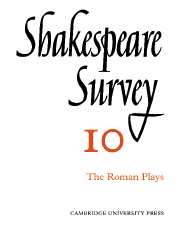Book contents
- Frontmatter
- Shakespeare’s Roman Plays: 1900–1956
- Shakespeare’s ‘Small Latin’—How Much?
- Shakespeare and the Elizabethan Romans
- The Metamorphosis of Violence in Titus Andronicus
- From Plutarch to Shakespeare: A Study of Coriolanus
- The Composition of Titus Andronicus
- Classical Costume in Shakespearian Productions
- Shakespeare’s Use of a Gallery over the Stage
- Lear’s Questions
- “Egregiously an Ass”: The Dark Side of the Moor. A view of Othello’s Mind
- Shakespeare in Schools
- Shakespeare Festival, Toronto, Canada
- International Notes
- Shakespeare Productions in the United Kingdom: 1955
- Drams of Eale, A Review of Recent Productions
- The Year's Contributions to Shakespearian Study 1 Critical Studies
- 2 Shakespeare’s Life, Times and Stage
- 3 Textual Studies
- Books Received
- Index
- Plate Section
Shakespeare in Schools
Published online by Cambridge University Press: 28 March 2007
- Frontmatter
- Shakespeare’s Roman Plays: 1900–1956
- Shakespeare’s ‘Small Latin’—How Much?
- Shakespeare and the Elizabethan Romans
- The Metamorphosis of Violence in Titus Andronicus
- From Plutarch to Shakespeare: A Study of Coriolanus
- The Composition of Titus Andronicus
- Classical Costume in Shakespearian Productions
- Shakespeare’s Use of a Gallery over the Stage
- Lear’s Questions
- “Egregiously an Ass”: The Dark Side of the Moor. A view of Othello’s Mind
- Shakespeare in Schools
- Shakespeare Festival, Toronto, Canada
- International Notes
- Shakespeare Productions in the United Kingdom: 1955
- Drams of Eale, A Review of Recent Productions
- The Year's Contributions to Shakespearian Study 1 Critical Studies
- 2 Shakespeare’s Life, Times and Stage
- 3 Textual Studies
- Books Received
- Index
- Plate Section
Summary
The teaching of Shakespeare’s plays in the grammar school, particularly in forms taking courses leading to the General Certificate of Education Examination, Ordinary Level, has its critics: some allege unsympathetic, biased and insensitive treatment of the plays; others assert that the plays should not be in the curriculum at all, on the grounds that not only are the classroom methods used unsuitable, but that the language and conventions of the plays themselves are too difficult for immature minds to grasp. All contend that irreparable harm is being done.
Why, in fact, are Shakespeare's plays included in the curriculum?
Education, properly conceived, demands not only the acquiring of skills, the assimilation of knowledge, the training of thought processes, but the leading of pupils to respond to works of art and thereby to increase and refine their understanding and enjoyment of artistic achievement. English Literature is the only subject, in schools where there is no classics side, that can consistently give this particular training. Music, Painting and Drawing are normally treated in a different way, they are more dependent on special skills and so are less accessible to children.
- Type
- Chapter
- Information
- Shakespeare Survey , pp. 107 - 110Publisher: Cambridge University PressPrint publication year: 1957

